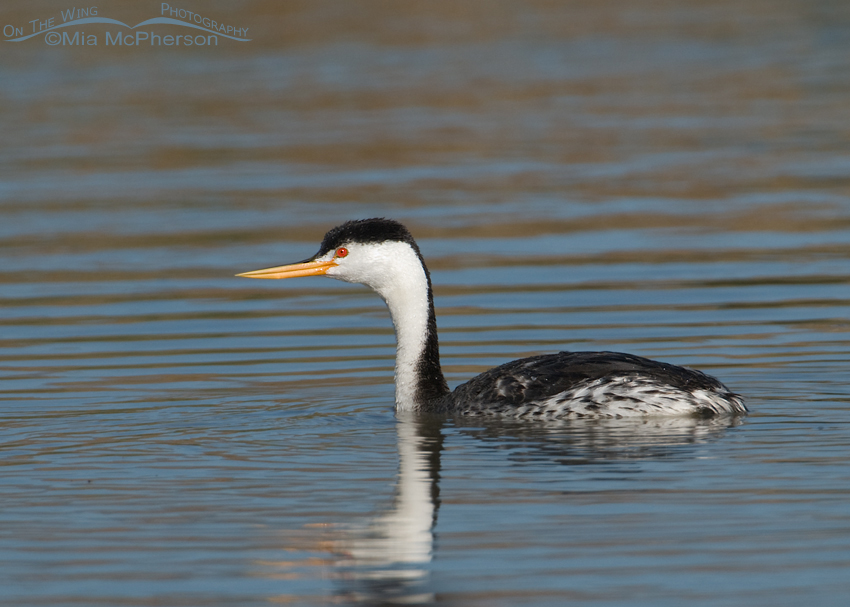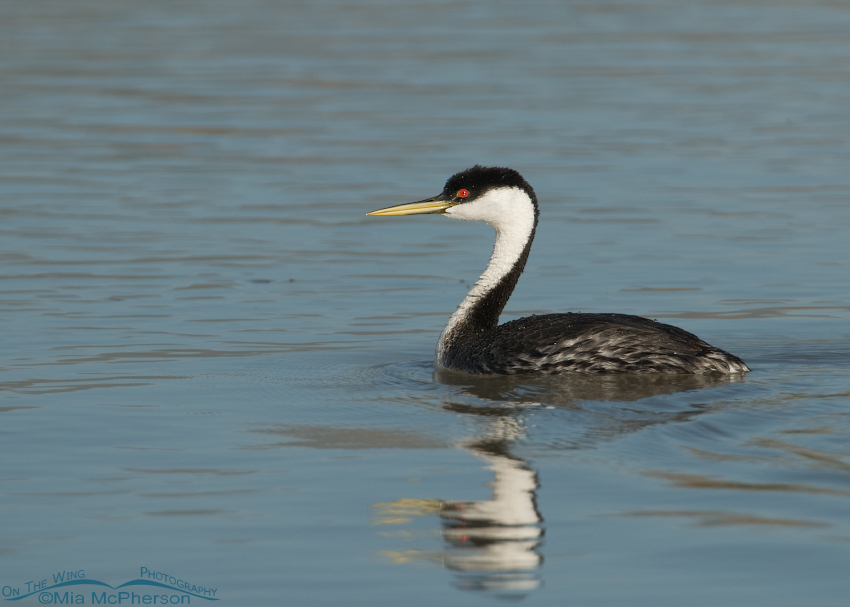Two grebe species that are often misidentified are the Clark’s and Western Grebes. The Clark’s and Western Grebes are very closely related and they can be difficult to distinguish. Western and Clark’s Grebes are found strictly in North America, they share the same types of habitat and breeding grounds. Both species are very gregarious throughout the year. Until 1985 they were thought to be the same species that were classified as different color forms. Today we know them as two separate species.
 Clark’s Grebe on rippled water – D200, f6.3, 1/1250, ISO 250, 200-400mm VR with 1.4x TC at 400mm, natural light
Clark’s Grebe on rippled water – D200, f6.3, 1/1250, ISO 250, 200-400mm VR with 1.4x TC at 400mm, natural light
This Clark’s Grebe (Aechmophorus clarkii) image was taken at Bear River Migratory Bird Refuge in northern Utah. Though similar in form to the Western there are some differences.
-
The Clark’s has a bright orange to yellow bill
-
The black crest of the Clark’s does not reach the eye, there is a thin white area between the crest and the red of the eye
-
The Clark’s has a thin black line on the nape and the neck itself is thin
-
The back of the Clark’s grebe is mostly gray and white usually shows on the bird’s flanks
The Clark’s Grebe above had just come up from a dive, the dark gray feathers of the back do look darker than normal when wet.
 Adult Western Grebe – D200, f7.1, 1/750, ISO 200, 200-400mm VR with 1.4x TC at 400mm, natural light
Adult Western Grebe – D200, f7.1, 1/750, ISO 200, 200-400mm VR with 1.4x TC at 400mm, natural light
This Western Grebe (Aechmophorus occidentalis) image was taken on the same day as the Clark’s Grebe at the same location. Without looking closely it would be easy to mistake it for a Clark’s or vice versa.
-
The bill of the Western Grebe is a greenish yellow and it is slightly upturned
-
The black crown of the Western extends below the eye, in non-breeding plumage the dark part around the eye can be a bit lighter
-
The S-shaped neck of a Western Grebe is slightly thicker than the Clark’s and the black neck stripe of the nape is shaped a little differently
-
The Western Grebe has a dark gray back and white does not usually show on the flanks while the grebe is floating on the water
Both species rarely come to land because the placement of their legs far back on the body makes it awkward for them to walk. Both species make their nests from floating vegetation though on occasion the nests are constructed on land. They mainly feed on fresh or saltwater fish and crustaceans. Both species winter along the pacific coast of the southwest and Mexico.
Personally I find the calls of the Western and the Clark’s Grebes to be delightful, especially when they squabble with each other.
Both of these grebes can be challenging to expose correctly because of the white whites and the dark plumage. Early morning, late afternoon or diffused light is best as well as using careful exposure compensation evaluation.
Life is good.
Mia
Click here to see more of my Clark’s Grebe photos plus facts and information about this species. Click here to see more of my Western Grebe photos plus facts and information about this species.


An excellent choice of images to use for this comparison.
There’d be fewer mis-identifications if more birders could get views this close in the field!